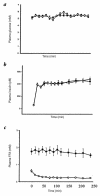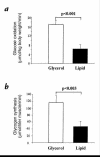Effects of free fatty acids on glucose transport and IRS-1-associated phosphatidylinositol 3-kinase activity - PubMed (original) (raw)
D Laurent, M Marcucci, M E Griffin, S Dufour, G W Cline, L A Slezak, D K Andersen, R S Hundal, D L Rothman, K F Petersen, G I Shulman
Affiliations
- PMID: 9916137
- PMCID: PMC407880
- DOI: 10.1172/JCI5001
Effects of free fatty acids on glucose transport and IRS-1-associated phosphatidylinositol 3-kinase activity
A Dresner et al. J Clin Invest. 1999 Jan.
Abstract
To examine the mechanism by which free fatty acids (FFA) induce insulin resistance in human skeletal muscle, glycogen, glucose-6-phosphate, and intracellular glucose concentrations were measured using carbon-13 and phosphorous-31 nuclear magnetic resonance spectroscopy in seven healthy subjects before and after a hyperinsulinemic-euglycemic clamp following a five-hour infusion of either lipid/heparin or glycerol/heparin. IRS-1-associated phosphatidylinositol 3-kinase (PI 3-kinase) activity was also measured in muscle biopsy samples obtained from seven additional subjects before and after an identical protocol. Rates of insulin stimulated whole-body glucose uptake. Glucose oxidation and muscle glycogen synthesis were 50%-60% lower following the lipid infusion compared with the glycerol infusion and were associated with a approximately 90% decrease in the increment in intramuscular glucose-6-phosphate concentration, implying diminished glucose transport or phosphorylation activity. To distinguish between these two possibilities, intracellular glucose concentration was measured and found to be significantly lower in the lipid infusion studies, implying that glucose transport is the rate-controlling step. Insulin stimulation, during the glycerol infusion, resulted in a fourfold increase in PI 3-kinase activity over basal that was abolished during the lipid infusion. Taken together, these data suggest that increased concentrations of plasma FFA induce insulin resistance in humans through inhibition of glucose transport activity; this may be a consequence of decreased IRS-1-associated PI 3-kinase activity.
Figures
Figure 1
Plasma concentrations of glucose (a), insulin (b), and FFAs (c) during the hyperinsulinemic-euglycemic clamp following 5 h of glycerol (open circles) or lipid (solid circles) infusion. FFA, free fatty acid.
Figure 2
Mean rates of glucose infusion during the hyperinsulinemic-euglycemic clamp following 5 h of glycerol (open bar) or lipid (solid bar) infusion.
Figure 3
(a) Mean rates of glucose oxidation assessed by indirect calorimetry (measured from t = 95–115 min). (b) Mean rates of muscle glycogen synthesis assessed by carbon-13 NMR (measured from t = 120 to 180 min) during the hyperinsulinemic-euglycemic clamp following 5 h of glycerol or lipid infusion.
Figure 4
Increment in intracellular [G-6-P] obtained from 20 to 60 min after beginning the hyperinsulinemic-euglycemic clamp following 5 h of glycerol or lipid infusion. [G-6-P], glucose-6-phosphate concentration.
Figure 5
Mean intracellular glucose concentration (assessed by carbon-13 NMR) and mean extracellular (plasma) glucose concentration obtained from 120 to 240 min during the hyperinsulinemic-euglycemic clamp following 5 h of glycerol or lipid infusion. *P = 0.04 versus intracellular glucose concentration during glycerol infusion.
Figure 6
IRS-1–associated PI 3-kinase activity in muscle biopsies obtained before the glycerol/lipid infusions (basal) and after 30 min of the hyperinsulinemic-euglycemic clamp following 5 h of glycerol or lipid infusion. PI, phosphatidylinositol.
Similar articles
- Free fatty acid-induced insulin resistance is associated with activation of protein kinase C theta and alterations in the insulin signaling cascade.
Griffin ME, Marcucci MJ, Cline GW, Bell K, Barucci N, Lee D, Goodyear LJ, Kraegen EW, White MF, Shulman GI. Griffin ME, et al. Diabetes. 1999 Jun;48(6):1270-4. doi: 10.2337/diabetes.48.6.1270. Diabetes. 1999. PMID: 10342815 - Insulin-stimulated insulin receptor substrate-2-associated phosphatidylinositol 3-kinase activity is enhanced in human skeletal muscle after exercise.
Howlett KF, Sakamoto K, Yu H, Goodyear LJ, Hargreaves M. Howlett KF, et al. Metabolism. 2006 Aug;55(8):1046-52. doi: 10.1016/j.metabol.2006.03.016. Metabolism. 2006. PMID: 16839840 Clinical Trial. - Dissociation between fat-induced in vivo insulin resistance and proximal insulin signaling in skeletal muscle in men at risk for type 2 diabetes.
Storgaard H, Jensen CB, Björnholm M, Song XM, Madsbad S, Zierath JR, Vaag AA. Storgaard H, et al. J Clin Endocrinol Metab. 2004 Mar;89(3):1301-11. doi: 10.1210/jc.2003-031243. J Clin Endocrinol Metab. 2004. PMID: 15001626 Clinical Trial. - Applications of NMR spectroscopy to study muscle glycogen metabolism in man.
Roden M, Shulman GI. Roden M, et al. Annu Rev Med. 1999;50:277-90. doi: 10.1146/annurev.med.50.1.277. Annu Rev Med. 1999. PMID: 10073278 Review.
Cited by
- Molecular nutrition research: the modern way of performing nutritional science.
Norheim F, Gjelstad IM, Hjorth M, Vinknes KJ, Langleite TM, Holen T, Jensen J, Dalen KT, Karlsen AS, Kielland A, Rustan AC, Drevon CA. Norheim F, et al. Nutrients. 2012 Dec 3;4(12):1898-944. doi: 10.3390/nu4121898. Nutrients. 2012. PMID: 23208524 Free PMC article. Review. - Stress Induced Hyperglycemia in the Context of Acute Coronary Syndrome: Definitions, Interventions, and Underlying Mechanisms.
Li M, Chen G, Feng Y, He X. Li M, et al. Front Cardiovasc Med. 2021 May 12;8:676892. doi: 10.3389/fcvm.2021.676892. eCollection 2021. Front Cardiovasc Med. 2021. PMID: 34055942 Free PMC article. Review. - Anabolic and anticatabolic agents in critical care.
Stanojcic M, Finnerty CC, Jeschke MG. Stanojcic M, et al. Curr Opin Crit Care. 2016 Aug;22(4):325-31. doi: 10.1097/MCC.0000000000000330. Curr Opin Crit Care. 2016. PMID: 27272101 Free PMC article. Review. - Pancreatic function, type 2 diabetes, and metabolism in aging.
Gong Z, Muzumdar RH. Gong Z, et al. Int J Endocrinol. 2012;2012:320482. doi: 10.1155/2012/320482. Epub 2012 May 17. Int J Endocrinol. 2012. PMID: 22675349 Free PMC article. - Flavonoids and Their Anti-Diabetic Effects: Cellular Mechanisms and Effects to Improve Blood Sugar Levels.
Al-Ishaq RK, Abotaleb M, Kubatka P, Kajo K, Büsselberg D. Al-Ishaq RK, et al. Biomolecules. 2019 Sep 1;9(9):430. doi: 10.3390/biom9090430. Biomolecules. 2019. PMID: 31480505 Free PMC article. Review.
References
- Reaven GM, Hollenbeck C, Jeng C-Y, Wu MS, Chen Y-D. Measurement of plasma glucose, free fatty acid, lactate, and insulin for 24h in patients with NIDDM. Diabetes. 1988;37:1020–1024. - PubMed
- Frayne KN. Insulin resistance and lipid metabolism. Curr Opin Lipidol. 1993;4:197–204.
- Steiner G, Morita S, Vranic M. Resistance to insulin but not to glucagon in lean human hypertriglyceridemics. Diabetes. 1980;29:899–905. - PubMed
- Thiebaud D, et al. Effect of long chain triglyceride infusion on glucose metabolism in man. Metab Clin Exp. 1982;31:1128–1136. - PubMed
Publication types
MeSH terms
Substances
Grants and funding
- R01 DK049230/DK/NIDDK NIH HHS/United States
- P60 AG-10469/AG/NIA NIH HHS/United States
- P30 DK-45735/DK/NIDDK NIH HHS/United States
- P30 DK045735/DK/NIDDK NIH HHS/United States
- R01 DK-49320/DK/NIDDK NIH HHS/United States
- M01 RR000125/RR/NCRR NIH HHS/United States
LinkOut - more resources
Full Text Sources
Other Literature Sources
Research Materials
Miscellaneous





